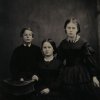One of the earliest and most historically significant ‘photographic diaries’, in the Alkazi Collection of Photography, is of the civil surgeon John Nicholas Tressider (1819-1898).
John Nicholas Tressider, a British doctor, was part of the esteemed Indian Medical Service from 1842 to 1877 , a profession that afforded him a chance to travel extensively. Tressicler was posted to Agra in 1851 and later based in Kanpur from 1854. His photographs, therefore, provide keen insights into aspects of the Uprising in Kanpur.
This invaluable photographic record provides an extraordinary visual journey of his extensive travels, professional and personal interactions, and at the same time, provides ample testimony to his keen eye and skill with the camera.
The album, archived in the Alkazi Foundation for the Arts, contains over one hundred and eighty pages of carefully preserved photographs that the civil surgeon himself pasted on the firm sheets, each accompanied by captions written by hand in ink and pencil. While the bulk of the photographs are albumen prints, there arc some salt prints as well.
Tressider managed to convince a cross section of individuals and personalities to pose in front of his lens. Among those photographed include ‘tehseeldars’, fellow medical surgeons, members of the Kanpur civil administration, landlords, members of his immediate family as well as distinguished military personnel that commanded various regiments during the upheaval of ’57. There are a number of ethnographic records of ‘natives’, anticipating the style of another official document, The People of India.’ The album in its present state is only partially bound, its pages having come out of the original string binding. However, all the loose pages along with the album cover have been carefully preserved to maintain the integrity of this priceless historical document.
Interestingly, the album contains some images that were shot by his close associates and fellow photographers Donald Home McFarlane (c.1830-1904), Dr. John Murray (c.1809-1898) and Felice Beato (c.1832-1909). Renowned practitioners in their own right, these individuals laid the foundations for the art of photography to thrive in India, in one of the foremost countries exposed to a lens. Tressider’s photographic memoir encompasses a wide array of individuals, events, sites and views. The large format pages carry a personal record of family, friends and colleagues. Apart from these it notably resurrects the events, individuals and sites of battle and massacres associated with the events of’ 1857. The photographs offer amongst the earliest documented images of the aftermath of the conflict. These include views of Wheeler’s Entrenchment in Kanpur, the site of the Bibighar slaughter, that witnessed a horrifying massacre of Europeans stationed in Kanpur who had been entrapped by the rebel sepoy army. Other prominent sites photographed include the Sati Chaura Ghat. The album reflects Tressider’s journey through the North Indian hinterland and eventually traces his journey back to his homeland in Falmouth, England.







